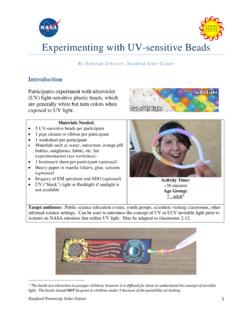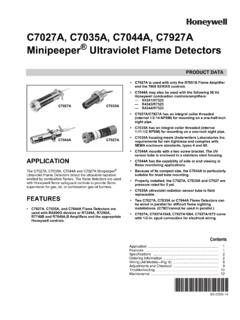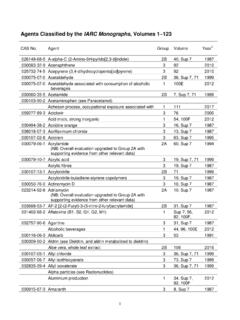Transcription of Space Based Astronomy Educator Guide pdf
1 National Aeronautics and Space AdministrationEducational ProductEducatorsGrades 5 8EG-2001-01-122-HQSpace- Based AstronomyAN Educator Guide WITH ACTIVITIES FOR SCIENCE, MATHEMATICS, AND TECHNOLOGY EDUCATION* Space Based 2/28/01 8:53 AM Page C1 Space - Based Astronomy An Educator Guide withActivities for Science, Mathematics, and TechnologyEducationis available in electronic format throughNASA Spacelink one of the Agency s electronicresources specifically developed for use by the educa-tional system may be accessed at the following address: * Space Based 2/28/01 8:54 AM Page C2 NATIONAL AERONAUTICS AND Space ADMINISTRATION| OFFICE OF HUMAN RESOURCES AND EDUCATION| EDUCATION DIVISION| OFFICE OF Space SCIENCEThis publication is in the Public Domain and is not protected by copyright. Permission is not required for AstronomyAN Educator Guide WITH ACTIVITIES FOR SCIENCE, MATHEMATICS, AND TECHNOLOGY EDUCATION* Space Based 2/28/01 8:54 AM Page iACKNOWLEDGMENTSMany thanks to the NASA Aerospace Education Services Program, NASA Teaching From SpaceProgram, NASA Educator Resource Center Network, and NASA Office of Space Science for theircontributions to the development of this :Gregory L.
2 Vogt, From Space ProgramNASA Johnson Space CenterHouston, TXNational Aeronautics and Space 304 image captures a sweeping prominence huge clouds of relatively cool dense plasma suspended in the Sun s hot,thin corona. At times, they can erupt, escaping the Sun s atmosphere. Emission in this spectral line shows the upper chro-mosphere at a temperature of about 60,000 degrees : Solar & Heliospheric Observatory (SOHO). SOHO is aproject of international cooperation between ESA and mosaic shows some of the highest resolution images obtained by the Solid State Imaging (SSI) system on NASA s Galileospacecraft during its eleventh orbit around Jupiter. The sun illuminates the scene from the left, showing hundreds of ridgesthat cut across each other, indicating multiple episodes of ridge formation either by volcanic or tectonic activity within the Jet Propulsion Laboratory, Pasadena, CA, manages the mission for NASA s Office of Space Science, Washington, DC.
3 JPLis a division of California Institute of Minuet of Galaxies: This troupe of four galaxies, known as Hickson Compact Group 87 (HCG 87), is performing an intricatedance orchestrated by the mutual gravitational forces acting between them. The dance is a slow, graceful minuet, occurringover a time span of hundreds of millions of Credit: Hubble Heritage Team (AURA/ STScI/ NASA). from a three dimensional visualization of Jupiter s equatorial region. These features are holes in the bright, reflective,equatorial cloud layer where warmer thermal emission from Jupiter s deep atmosphere can pass through. The circulation pat-terns observed here along with the composition measurements from the Galileo Probe suggest that dry air may be converg-ing and sinking over these regions, maintaining their cloud-free Jet Propulsion Laboratory, Pasadena, CA,manages the Galileo mission for NASA s Office of Space Science, Washington, DC.
4 JPL is an operating division of CaliforniaInstitute of image of the planet Saturn and natural satellites Tethys and Dione was taken on January 29, 1996, by Voyager striking NASA Hubble Space Telescope picture shows three rings of glowing gas encircling the site of supernova 1987A, astar which exploded in February 1987. The supernova is 169,000 light years away, and lies in the dwarf galaxy called the LargeMagellanic Cloud, which can be seen from the southern : Dr. Christopher Burrows, ESA/STScI and find out more about these images and projects, please visit the Cover Images* Space Based 2/28/01 8:54 AM Page iiAcknowledgments ..iiIntroduction ..1 How to Use This Guide ..3 The Space Age Begins ..5 Astrophysics ..7A Brief History of United States Astronomy Spacecraft and Crewed Space Flights ..9 Activity UnitsUnit 1: The Atmospheric Filter.
5 17 Unit 2: The Electromagnetic Spectrum ..23 Unit 3: Collecting Electromagnetic Radiation ..53 Unit 4: Down to Earth ..71 Unit 5: Space - Based Astronomy on the Internet ..91 Glossary ..94 Suggested Reading ..97 NASA Educational Resources ..99 Reply Card ..101 Space - Based AstronomyActivity Guide for Science, Mathematics, and Technology EducationiiiTABLE OF CONTENTS* Space Based 2/28/01 8:54 AM Page iiiIt would seem that when it comes to observingthe universe, the larger the instrument, the bet-ter. This is true up to a point, but there are lim-its limits not imposed by technology but bynature Earth is a life-sustaining atmos-phere that stands between our eyes and the radi-ation that falls upon Earth from outer radiation is comprised of a very broad spec-trum of energies and wavelengths. Collectively,they are referred to as the electromagnetic spec-trum.
6 They range from radio and microwaveradiation on the low energy (long wavelength)end through infrared, visible, ultraviolet , and x-rays to gamma rays on the high energy (shortwavelength) end. Gases and other componentsof our atmosphere distort, filter, and block mostof this radiation permitting only a partial pic-ture, primarily visible radiation and some radiowaves, to reach Earth s surface. Although manythings can be learned about our universe bystudying it from the surface of Earth, the story isincomplete. To view celestial objects over thewhole range of the electromagnetic spectrum, itis essential to climb above the atmosphere intoouter its earliest days, the National Aeronauticsand Space Administration (NASA) has used theemerging technology of rockets to explore theuniverse.
7 By lofting telescopes and other scientif- Space - Based AstronomyActivity Guide for Science, Mathematics, and Technology Education1 INTRODUCTIONIf you go to the country, far from city lights, you can see about 3,000 stars on a clearnight. If your eyes were bigger, you could see many more stars. With a pair of binoc-ulars, an optical device that effectively enlarges the pupil of your eye by about 30times, the number of stars you can see increases to the tens of thousands. With amedium-sized telescope with a light-collecting mirror 30 centimeters in diameter,you can see hundreds of thousands of stars. With a large observatory telescope,millions of stars become visible.* Space Based 2/28/01 8:54 AM Page 1ic instruments above the veil of Earth s atmos-phere, NASA has delivered a treasure house ofinformation to astronomers, leading them torethink their most fundamental ideas about whatthe universe is, how it came to be, how it func-tions, and what it is likely to Aeronautics and Space Administration2* Space Based 2/28/01 8:54 AM Page 2 The Guide begins with a survey of Astronomy -related spacecraft NASA has sent into outerspace.
8 This is followed by a collection of activitiesorganized into four units: The AtmosphericFilter, The Electromagnetic Spectrum, CollectingElectromagnetic Radiation, and Down to curriculum matrix identifies the curriculumareas each activity addresses. Following theactivities is information for obtaining a 35 mmslide set with descriptions showing currentresults from NASA spacecraft such as theHubble Space Telescope (HST), ComptonGamma Ray Observatory (CGRO), and theCosmic Background Explorer (COBE). Theguide concludes with a glossary, a reference list,a NASA Resources list, and an evaluation from users of this Guide is essential forthe development of future editions and otherclassroom supplementary materials. Space - Based AstronomyActivity Guide for Science, Mathematics, and Technology Education3 HOW TO USE THIS GUIDEThis curriculum Guide uses hands-on activities to help students and teachers understandthe significance of Space - Based Astronomy astronomical observations made fromouter Space .
9 It is not intended to serve as a curriculum. Instead, teachers should selectactivities from this Guide that support and extend existing study. The Guide contains fewof the traditional activities found in many Astronomy guides such as constellation stud-ies, lunar phases, and planetary orbits. It tells, rather, the story of why it is important toobserve celestial objects from outer Space and how to study the entire electromagneticspectrum. Teachers are encouraged to adapt these activities for the particular needs oftheir students. When selected activities from this Guide are used in conjunction with tra-ditional Astronomy curricula, students benefit from a more complete experience.* Space Based 2/28/01 8:54 AM Page 3A much larger Sputnik 2 followed, carrying asmall dog as a passenger. Although primarilyinvestigating the response of living things to pro-longed periods of microgravity, Sputnik 2 didsense the presence of a belt of high-energycharged particles trapped by Earth s magneticfield.
10 Explorer 1, the United States first satellite,defined that field further. The cylindrical, kilogram Explorer 1 rodeto Space on top of a Juno I rocket on January 31,1958. It was launched by the United States Armyin association with the National Academy ofSciences and the Jet Propulsion Laboratory ofthe California Institute of Technology. NASAwas not created formally by an act of Congressuntil the following October. Explorer 1 carried scientific instrumentsdesigned by Dr. James Van Allen of theUniversity of Iowa. Circling Earth in an orbitranging from 360 to 2,531 kilometers, thesatellite radioed back radiation measurements,revealing a deep zone of radiation surroundingEarth. Born of the technology of World War II and thetensions of the Cold War, the Space age began inSpace- Based AstronomyActivity Guide for Science, Mathematics, and Technology Education5 THE Space AGE BEGINSW ithin months of each other, the United States and the Soviet Union launchedtheir first artificial satellites into orbit around Earth.

















